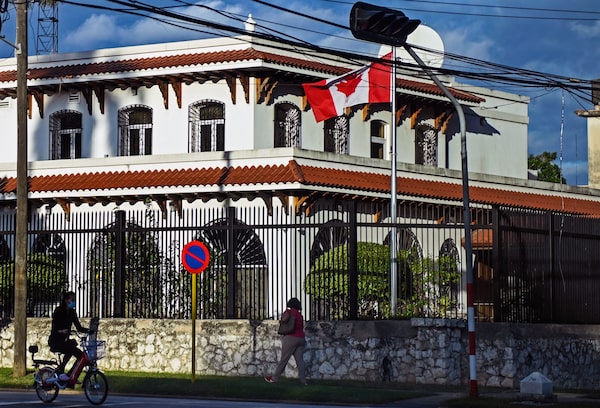
Canada's Embassy in Havana, on Nov. 30, 2021. A group of 18 Canadian diplomats are suing their government on the grounds that they begun to suffer headaches, visual disturbances and nausea, after being stationed in Cuba.YAMIL LAGE/Getty Images
For the Canadian embassy staff who suffered strange and sometimes debilitating brain-related health effects starting in 2016, the latest news reports on “Havana syndrome” have provided something they’ve sought for years – a plausible motive for their injuries.
The investigative reports, broadcast on Sunday on 60 Minutes and published originally in The Insider, a magazine produced in Latvia by Russian dissident journalists and in the German newsmagazine Der Spiegel, include leaked documents showing that Russian intelligence officials have been attempting to develop energy weapons for a number of years, using either microwave or ultrasound technology. The Insider reporters obtained Russian documents showing that such research has received funding and officials have been rewarded for their work.
The reporting also speculates that such weapons may have been deployed against U.S. and NATO-country officials after Russia first invaded Ukraine in 2014 and also around the time of the second invasion in 2022. Although it does not provide evidence of an existing weapon or of specific attack plans, it cites a number of instances in which diplomatic and defence officials attending Ukraine-related events in Brussels, Vienna and other cities reported “anomalous health incidents” ranging from chronic headaches and weakness to concussion-like effects, consistent with the symptoms suffered by the Havana staff.
The reporting, though lacking hard evidence of specific attacks and questioned by some scientists, is the first to provide a narrative that might explain why Canadians would have been targeted in a set of incidents more famous for their effects on U.S. government officials in Cuba, experienced at a time when Canada had good relations with Cuba.
“My reaction that it may be the Russians? I’m relieved,” said a former diplomat from Canada’s embassy in Cuba who, like her colleagues, has asked not to have her name printed out of fear for her security. “Yes, I’m relieved my family and I may have been targeted and attacked by Russian spies wanting to neutralize us. As horrible as this situation may seem, it is nothing compared to being ignored and treated as if this medical hell my kids and I have been trying to survive for the past six years is entirely a figment of my imagination.”
A series of large-scale studies by medical, diplomatic and intelligence organizations over the past two years has generally concluded that the symptoms could not have been produced by energy-weapon attacks.
A Canadian medical study by brain scientists and other specialists at Dalhousie University concluded in 2019 that the Canadian victims did have detectible brain injuries, which they found could have been caused psychologically but were more likely produced by pesticides used heavily in Cuba in 2016 to control the Zika virus.
A large-scale study commissioned by the U.S. State Department concluded in 2022 that an energy weapon or directed attack was “highly unlikely,” both scientifically and logistically. The seven major U.S. intelligence agencies studied the issue in 2023 and concluded that such a weapon, even if scientifically possible, was “very unlikely” to have been the cause of the symptoms. And in March, 2024, the National Institutes of Health published brain-scan studies of the victims which concluded that they had not been subjected to external forces.
A total of 18 Canadians, including seven children, have reported suffering effects starting in 2016. Some have recovered and returned to school or work, but some are still receiving treatment for chronic symptoms. In response to the cases, Ottawa reduced its Havana mission in 2019 to a skeleton staff, and all of the victims are currently in Canada.
In 2019, this group launched a lawsuit claiming that Ottawa ignored evidence of danger they faced and did not provide sufficient care for their injuries. That case is still before the courts.
While medical and scientific experts agree that the symptoms appear to be real and measurable and the suffering genuine, experts on energy weapons reacted to the new reports with skepticism, since there is no concrete evidence that energy weapons have been produced or could be deployed this way.
“I don’t see signs that point to there being a weapon,” said Cheryl Rofer, a scientist who worked at Los Alamos National Laboratory with teams attempting to develop similar high-tech weapons and who has written about the scientific implausibility of such weapons. “This research has been going on, on both sides, since the 1970s, and I see no signs in this reporting that anything has been found that fits those specs.”
Likewise, she noted, the symptoms and circumstances seem not to match those of a microwave weapon, which would be expected to produce skin-burning effects that have not been reported in any of the major cases, or ultrasonic weapons, which would require a large high-powered device.
The former Canadian embassy staff, whose jobs ranged from senior diplomatic positions in political affairs to maintenance and technical matters, have not endorsed a specific explanation for their injuries, but have repeatedly said that they do not believe they could have a psychological cause.
“No sci-fi spy or covert war weapon could ever be worse than feeling I lost my credibility,” the former Canadian diplomat said. “And this is how the government of Canada has made us feel year after year – it has taken away my confidence and my joy.”
 Doug Saunders
Doug Saunders